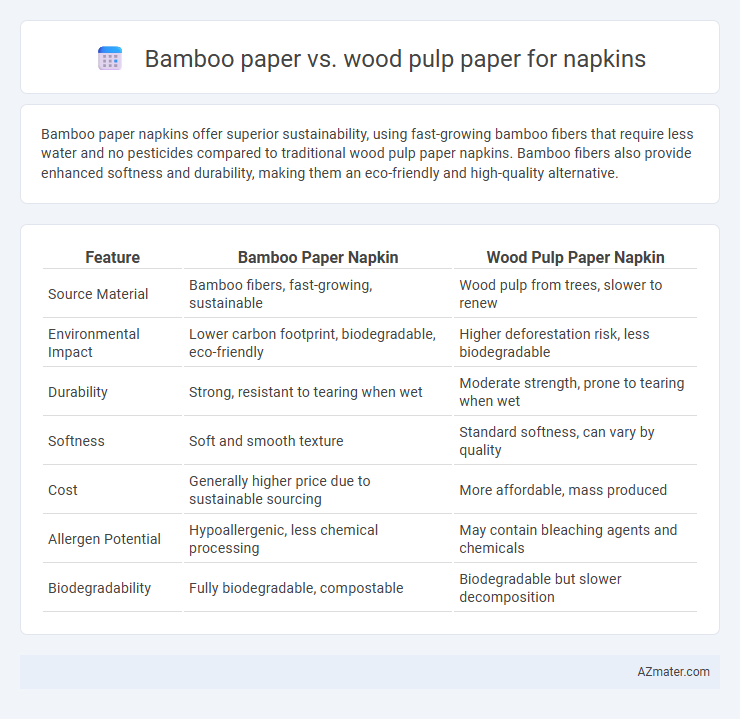Bamboo paper napkins offer superior sustainability, using fast-growing bamboo fibers that require less water and no pesticides compared to traditional wood pulp paper napkins. Bamboo fibers also provide enhanced softness and durability, making them an eco-friendly and high-quality alternative.
Table of Comparison
| Feature | Bamboo Paper Napkin | Wood Pulp Paper Napkin |
|---|---|---|
| Source Material | Bamboo fibers, fast-growing, sustainable | Wood pulp from trees, slower to renew |
| Environmental Impact | Lower carbon footprint, biodegradable, eco-friendly | Higher deforestation risk, less biodegradable |
| Durability | Strong, resistant to tearing when wet | Moderate strength, prone to tearing when wet |
| Softness | Soft and smooth texture | Standard softness, can vary by quality |
| Cost | Generally higher price due to sustainable sourcing | More affordable, mass produced |
| Allergen Potential | Hypoallergenic, less chemical processing | May contain bleaching agents and chemicals |
| Biodegradability | Fully biodegradable, compostable | Biodegradable but slower decomposition |
Introduction: Why Napkin Material Matters
Napkin material directly impacts absorbency, softness, and environmental sustainability, making the choice between bamboo paper and wood pulp paper crucial. Bamboo napkins offer superior biodegradability and faster renewability compared to traditional wood pulp napkins, which often involve deforestation and chemical processing. Selecting bamboo enhances eco-friendliness and durability while maintaining essential napkin performance characteristics.
What Is Bamboo Paper?
Bamboo paper is made from bamboo fibers, which are more sustainable and eco-friendly compared to traditional wood pulp paper used for napkins. Bamboo grows rapidly, requiring less water and no pesticides, making it a renewable resource with a lower environmental footprint. Its natural antibacterial properties and durability provide a soft yet strong alternative ideal for napkin production.
What Is Wood Pulp Paper?
Wood pulp paper, commonly used for napkins, originates from grinding wood fibers into a pulp, which is then processed to create a soft, absorbent material. This paper type is known for its cost-effectiveness and durability in everyday use, making it a traditional choice in the paper industry. However, wood pulp paper often involves significant chemical treatments and deforestation concerns, contrasting with more sustainable alternatives like bamboo paper.
Production Process: Bamboo vs Wood Pulp
Bamboo paper for napkins is produced using natural bamboo fibers that undergo a mechanical or chemical pulping process, which is often more sustainable due to bamboo's rapid growth and lower need for pesticides. Wood pulp paper napkins require harvesting mature trees, followed by pulping that typically uses more water and chemicals, leading to greater environmental impact. The bamboo production process results in softer, stronger fibers, enhancing napkin durability while reducing resource consumption compared to traditional wood pulp methods.
Environmental Impact Comparison
Bamboo paper for napkins offers significantly lower environmental impact compared to wood pulp paper, as bamboo grows rapidly with minimal water and pesticide requirements, promoting sustainability. The processing of bamboo fibers generates fewer greenhouse gas emissions and reduces deforestation risks inherent in wood pulp paper production. Bamboo napkins also biodegrade faster, enhancing their eco-friendly profile in waste management and composting systems.
Strength and Durability Analysis
Bamboo paper napkins exhibit superior strength and durability compared to wood pulp paper due to bamboo fibers' natural tensile strength and longer fiber length, which enhance resistance to tearing and moisture absorption. Bamboo's dense fiber structure allows napkins to maintain integrity when wet, making them ideal for heavy-duty use and prolonged handling. In contrast, wood pulp paper napkins tend to break down more quickly under stress and moisture exposure, reflecting lower durability in demanding applications.
Softness and Comfort Differences
Bamboo paper napkins offer superior softness compared to traditional wood pulp paper due to the microfiber structure of bamboo fibers, which feel gentler on the skin. The natural antimicrobial properties of bamboo enhance comfort by reducing irritation and promoting a fresher feel during use. Wood pulp paper napkins tend to be coarser and may cause discomfort for sensitive skin, making bamboo an optimal choice for softness and comfort.
Cost and Market Availability
Bamboo paper napkins generally have a higher production cost due to the specialized processing required, making them more expensive than wood pulp paper napkins. Wood pulp paper napkins dominate the market with widespread availability and established supply chains, contributing to their lower price point and common usage. The eco-friendly appeal of bamboo paper is driving niche demand, but it remains less accessible and costlier compared to traditional wood pulp options.
Consumer Preferences and Trends
Consumers increasingly prefer bamboo paper napkins due to their eco-friendly qualities, such as rapid renewability and biodegradability, compared to traditional wood pulp paper. Market trends show a rise in demand for sustainable products, with bamboo napkins appealing to environmentally conscious buyers seeking reduced deforestation impact. Bamboo paper also offers comparable softness and strength, aligning with consumer expectations for comfort and durability in napkin products.
Conclusion: Choosing the Right Napkin Paper
Bamboo paper offers superior sustainability and biodegradability compared to traditional wood pulp paper, making it an eco-friendly choice for napkins. Its natural antimicrobial properties and higher absorbency enhance hygiene and functionality in daily use. Selecting bamboo napkins supports environmental conservation while maintaining quality, whereas wood pulp napkins remain cost-effective but less sustainable.

Infographic: Bamboo paper vs Wood pulp paper for Napkin
 azmater.com
azmater.com